Panchromatic Make-up
Most early American black and white silent movies were made using blue-sensitive or orthochromatic film. These film stocks were insensitive to red light which meant that, in early black and white movies, reds looked black and natural skin tended to look dark and dirty on the screen. Applying stage make-up in the traditional way proved to be problematic and many early screen actors resorted to using bright blue, green and/or yellow make-up to achieve a suitable result. Things must have looked very strange on early movie sets.
See also: Early (Silent) Movie Make-up
Panchromatic film
Panchromatic film, as its name implies, is sensitive to the complete range of the visible spectrum, so black and white movies made with it had colours rendered more faithfully as tonal shades of grey than movies made with blue-sensitive or orthochromatic film. Experiments with panchromatic film occurred as early as 1913 in the United States and it was used in some American films as early as 1918. However, it was not until 1922 that a complete American movie (The Headless Horseman, Sleepy Hollow Corp.) was shot entirely with panchromatic film stock.
Any American cinematographer who wanted to use panchromatic film before 1922 had to order it specially as, prior to that date, it was not a regular product of the Eastman Kodak Company – the main supplier of film stock in the United States. Although panchromatic film had a wider spectrum sensitivity than blue-sensitive or orthochromatic film, its use was constrained by it being less stable, slower, and more expensive. Some cinematographers put up with these limitations and used it for outdoor shots because it produced superior images of landscapes and clouds (Bordwell, Staiger & Thompson, 1985, p. 283).
In 1923, Eastman Kodak began commercial production of a new, more stable, and faster panchromatic film and then, in 1926, lowered its price to a level that was similar to the orthochromatic film it also produced. As well as reducing its price, Eastman Kodak began to actively promote the new film, pointing out its ability to render skin tones more faithfully in close-ups, and to produce better pictures of landscapes and skies in outdoor scenes (Bordwell, Staiger & Thompson, 1985, p. 284). The switch by Hollywood from blue-sensitive or orthochromatic to panchromatic film was very rapid after that.
The adoption of sound recording after 1927 – which required replacing arc lamps with quieter tungsten lamps – also played a role, as did the release by Du Pont of its panchromatic film onto the American market in 1928, and the introduction by Eastman Kodak of its Ciné Panchromatic Type II film in the same year (Mees, 1954, p. 126). By the time Eastman Kodak’s Super-Sensitive Ciné Panchromatic film arrived in 1931 the conversion was largely complete.
Make-up
Panchromatic film was sensitive to all the colours in the visible spectrum so the make-up practices used for blue-sensitive or orthochromatic film no longer worked and make-up artists and film studios had to adjust. Perc Westmore [1904-1970], for example, created a panchromatic make-up by combining Stein’s pink greasepaint with eye shadow (Grant, 2007, p. 110). Some studios however, simply abandoned greasepaint or decided not use make-up at all in their panchromatic films.
Improved cameras, better lighting and more sensitive film are making it possible for the stars to appear before the lens without reinforced layers of grease and cosmetics.
In the early days, faces were done in yellow to make them photograph lighter. Since then they have passed through most of the colors of the rainbow, some actors even using blue and purple paints to gain better effects.
Women with their finer skins and lighter coloring fared well enough but the “he-men” of the thrillers were wont to be reflected with the faces of ghastly pallor but with necks and arms that photographed as shocking challenges to soap and water.
But even with the technical improvements made, dethroning of King Grease Paint is not without a struggle. Actors recruited from the stage are hard to wean from the grease pot. They blush at the facial nudity of acting a part without a mask of paint.
The announcement of Cecil De Mille that he will produce his next picture without grease paint being used by any of the players stirred some protest, more of it, surprisingly from the men than from the women.
Allan Dwan, in directing the Paramount picture, “Sea Horses,” had a cast including Florence Vidor, Jack Holt, William Powell, George Bancroft and others that used no make-up. It was successful.(Milwaukee Sentinel, April 2, 1926, p. 90)
Given the practices of the past, it might be thought that Hollywood would respond to the change in film stocks the way it had previously coped with any new technology, that is, in an ad hoc manner. However, Hollywood in 1925 was a very different place from the way it had been before the First World War.
Hollywood
Hollywood in 1925 was more homogenised than it had been in 1914. The founding of the Society of Motion Picture Engineers (1916), the American Society of Cinematographers (1918), and the Motion Picture Make-up Artists Association (1927) meant that information was now more widely shared.
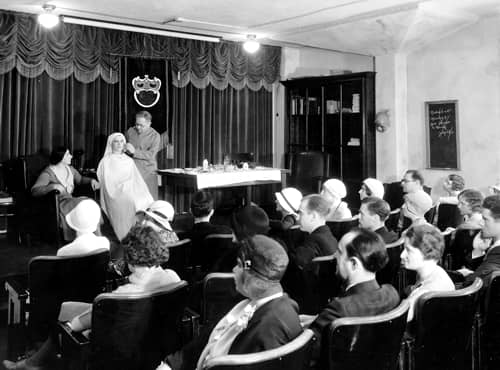
Above: 1930 Max Factor [1872-1938] giving a lecture at a meeting of the Motion Picture Make-up Artists Association. Their coat of arms is hanging on the curtain behind him. Max Factor donated the use of a room at 1666 North Highland Avenue for the meetings.
These bodies also proposed and maintained standards and promoted progress across the industry as a whole. One outcome of this was an increasing level of technological standardisation, a process that was accelerated by the founding of the Academy of Motion Picture Arts and Sciences in 1927 (Bordwell, Staiger & Thompson, 1985, pp. 254-255). The development of these institutions meant that when new technologies arrived on the market they were frequently referred to committees for evaluation.
The Mazda tests
In 1927, some studios using panchromatic film began to switch their lighting to incandescents – also known as Mazda lamps or ‘Inkies’. These lamps produced light across the full spectrum, unlike the Cooper-Hewitt mercury-vapour lamps that produced light predominantly in the blue-green end. Inkies were also more portable and, as they used less current, required less maintenance, were easier to change, and cheaper to run (Bordwell, Staiger & Thompson, 1985, p. 294). Incandescents were also much quieter than arc lamps, a factor that became critically important after the introduction of ‘talkies’ in 1927.
There was no industry standard for incandescents, so the Technicians’ Branch of the newly formed Academy of Motion Picture Arts and Sciences proposed that lighting tests be conducted.
The Technicians’ Branch invited all suppliers of incandescent equipment and panchromatic film to send representatives and new equipment. General Electric contributed thousands of dollars worth of lamps, and Mole-Richardson sent their entire line of products. Du Pont, Eastman, and Agfa supplied free film and processing. Max Factor donated a make-up artist and make-up materials. Eventually, over a dozen service firms participated in the tests.
(Bordwell, Staiger & Thompson, 1985, p. 295)
The tests, involving lighting, cameras, film and make-up, were conducted early in 1928 at the Warner Brothers Studios. Known as the Mazda tests, they would establish incandescent light and panchromatic film as industry norms, a situation that was reinforced as more and more films were made with sound.
Eventually, two revolutionary technical developments made the incandescent light imperative. The first of these was the development of panchromatic film. In this type of film, the sensitivity is not only in the blue end of the spectrum, but extends far into the yellow and red. So it was soon found that inkie light was far more efficient with this film than was either the arc or the vapor tube. The second innovation, which followed close on the heels of the first, was sound. When the microphone appeared on the set, it demanded absolute silence—and the arcs sizzled and sputtered very loudly, while the Mazda bulb was, once it was warmed up, completely silent. Therefore, as sound pictures became the rule, the incandescent light became, perforce, universally accepted. This acceptance was given grudgingly, but as time wore on, and we became more and more accustomed to using inkies, we found that they were, after all, a real improvement. Therefore, even now that the arc has been satisfactorily silenced, very few cinematographers have returned to their use.
(Howe, 1931, p. 50)
Max Factor
The Max Factor company sent the make-up artist Edward Kaufman to participate in the Mazda tests. During the four months of testing the company succeeded in developing a panchromatic make-up that made allowances for the differences between the colour sensitivity of panchromatic film and the human eye, as well as the spectral output of incandescent lights. Although panchromatic film registered light across the full visible spectrum it was more sensitive to blue than red, unlike the incandescent lamps which put out more red than blue. So, a make-up was needed which balanced the colours and produced a monochrome image that looked natural to the human eye.
The eye sees yellow, more readily than any other color, with a relative proportion of more red than blue. The photographic emulsion, on the other hand, does not record in the same manner. As is known, the panchromatic photographic emulsion has a high sensitivity in the blue, with a proportionately lesser sensitivity in the red.
The characteristics of the Mazda illumination, on the contrary, as used on the motion picture sets are relatively low in the blue and very high in the red end of the spectrum. The characteristics of photographic emulsions that are particularly sensitive to the blue give rise to the condition of a too dark color rendering in the red end of the spectrum and too light in the blue.
… The purpose of make-up, then, is to add to the face sufficient blue coloration in proportion to red in order that the photographic tonal rendition will be such as the eye sees in real life, and to prevent excessive absorption of light by the face.(Factor, 1937, p. 54)
Max Factor was also concerned about the psychological effect on the actors and, unlike make-up of earlier times, attempted to keep the new Panchromatic Make-up as natural looking as possible.
The psychological problem must also be considered. A combination of the correct blue-violet and yellow-orange with sufficient blue in a range that would be desirable for a correct panchromatic recording would result in a brownish make-up. On the motion picture set before the camera, this brownish make-up would distinctly affect the psychological responses of the players; for example, if two players were enacting an emotional scene and had to look at each other in unnatural colors, a certain interference of response would result. Even though containing the desirable panchromatic colors in the make-up composition, the make-up must be sufficiently natural to overcome this psychological factor.
(Factor, 1937, pp. 54-55)
The lack of suitable colormetric instruments meant that colours were selected largely through trial-and-error with the final colours ranging from No. 21 with no blue, through to No. 31. Darker colours were achieved by increasing the amount of yellow and blue with relatively less red (Factor, 1937, p. 61). The trial-and-error nature of the process led Max Factor to refine its recommendations between 1928 and 1930.

Above: 1928 Make-up colours for Max Factor Panchromatic Make-up (Factor, 1928, p. 22).
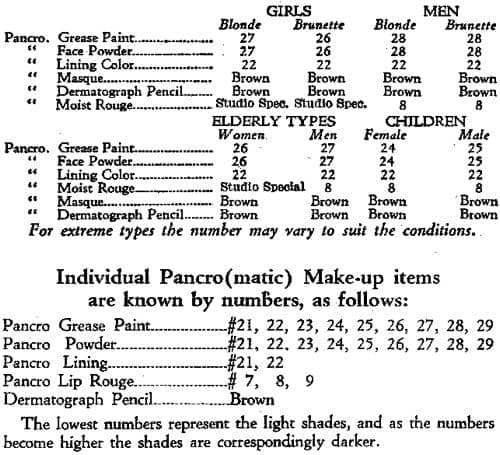
Above: 1929 Make-up colours for Max Factor Panchromatic Make-up (Factor, 1929, p. 9).
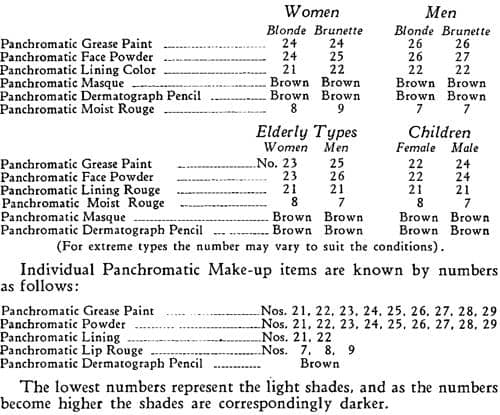
Above: 1930 Make-up colours for Max Factor Panchromatic Make-up (Factor, 1930, pp. 161-162).
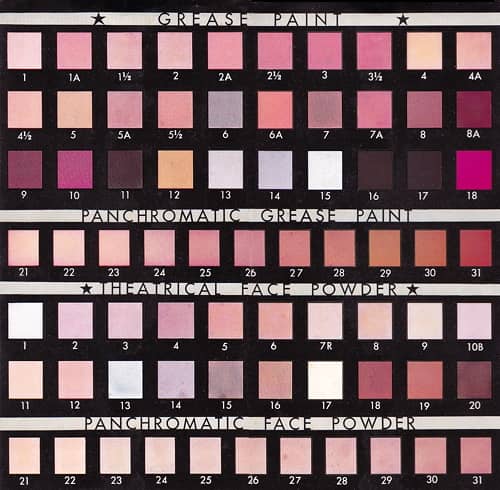
Above: 1933 Max Factor Color Charts for Grease Paint, Panchromatic Grease Paint, Theatrical Face Powder, and Panchromatic Face Powder.
Panchromatic powders, added to set the greasepaint and reduce its sheen and reflection, also came in shades ranging from 21 to 31. The recommended shade of Panchromatic Face Powder was matched to the underlying Panchromatic Greasepaint which helped to reduce the problem of the make-up gradually lightening as new powder was added during a filming session. The final result was a much more natural make-up than the blues and yellows sometimes employed in the past to cope with the older blue-sensitive or orthochromatic film.
Formerly grease-paints of intense colours, especially rich, bright yellows and vivid greens, were employed to give the desired effects. It has been found, however, as might be expected on theoretical grounds, that with the introduction of panchromatic films and improved forms of lighting, softer tones of yellowish or brownish flesh-coloured grease-paints give much better and more natural-looking results. There is, in consequence, a tendency nowadays towards the use of more natural flesh tints than those amazing yellows and greens which made the movie studios of yesterday appear such queer, ghost-haunted places.
(Redgrove & Foan, 1930, p. 149)
Formulation
Max Factor’s Panchromatic Greasepaint was a cream not a stick. It was spread with moistened fingertips which suggests that it was not produced simply by suspending finely ground pigments in an unguent or oil base, as this would be immiscible with water. It was easy to use, could be applied very thinly, and did not need cold cream or mineral oil as a base. Like his earlier Flexible Greasepaint it was sold in tubes which Max Factor thought made the make-up more sanitary.
Because the old theatrical stick make-up was not easily applied and was unsanitary, the unguent form of make-up, with a base composed of vegetable oils, was introduced in a collapsible tube. Soon the old theatrical stick make-up was discarded in favor of the unguent panchromatic foundation color.
The unguent base aided in the manufacturing processes since the pigments could be introduced in closer balance and could be added in finer and smoother forms. … Because of the fineness of the pigment in the unguent panchromatic make-up, it is possible to apply a desired protective color coating adequately without an unduly heavy application of the make-up.(Factor, 1937, p. 60)
Application
The Max Factor company provided detailed instructions on how panchromatic greasepaint was to be applied.
Directions for the Application of Make-Up
1. Preparing the Face—The face must be thoroughly cleaned before make-up is applied. The best way is to wash the face with soap and water. Men should be smoothly shaven.
2. Base for Grease Paint—It is often necessary to use cold cream before applying grease paint. In my laboratory, however, we have developed a grease paint which eliminates this need.
3. Grease Paint Application—Squeeze about one-quarter of an inch of grease paint from the tube into the palm of the hand. Then with the tips of the fingers of the other hand apply the grease paint in “dibs and dabs,” covering the face with little dots of grease paint until it acquires the appearance of a freckled face. Grease paint must be applied sparingly, too much will spoil your make-up.
4. Spreading Grease Paint—Now remove the grease paint from the hands and dip them into cool water, then with the finger tips moistened with water spread the grease paint over the face, blending it smoothly, evenly and thinly into the skin. The movement of the fingers should be from the center of the face outward. Keep dipping finger tips into water as it is essential to blend the grease paint in order to have a smooth and thin application.(Factor, 1930, pp. 157-158)
Panchromatic Make-up was removed in the usual fashion with a cold cream.
Adoption
Max Factor’s Panchromatic Make-up was developed in conjunction with the Academy and the film studios so it became an American industry standard. It was rapidly adopted by Hollywood, a process helped by the fact that the major studios had make-up departments and, as Hollywood began to dominated the movie industry both at home and abroad, it was soon found in film studios worldwide.
Today what we call Panchromatic Make-Up is the rule, being used by every studio in America and the principal studios throughout the world. And the development of Panchromatic Make-Up we consider one of the most important achievements in the art. This was brought about because of the introduction of Panchromatic film, a film sensitive to all colors, recording them in their true, harmonious relations, and eliminating finally those sharp, hard contrasts so common with the use of the old-time orthochromatic film.
(Factor, 1930, p. 158)
The development of Panchromatic Make-up helped Max Factor consolidate his company in a preeminent position vis-à-vis Hollywood and it became the ‘first point of call’ for any new development in Hollywood that required testing for make-up.
After 1928, to guarantee uniformity, Factor had to create careful testing and research procedures. By 1934, his factory had an assembly-line operation, a quality-control laboratory, and a research laboratory to develop new formulas. Every innovation in lighting or film stock sent studios to Factor, and the company devised make-up to suit faster emulsions, arc lamps, three-color Technicolor, and Eastman Color.
(Bordwell, Staiger & Thompson, 1985, p. 293)
All in all, Max Factor came out very well from the Mazda tests. An already strong relationship between the company and Hollywood was strengthened. The award presented to him in 1928 by the Academy recognising his company’s valuable service was a bonus.
See also: Max Factor
First Posted: 26th February 2013
Last Update: 28th October 2020
Sources
Academy of Motion Picture Arts and Sciences. (1928). Academy reports (No. 1). Incandescent illumination. Author.
Bordwell, D. Staiger, J., & Thompson, K. (1985). The classical Hollywood cinema. Film style & mode of production to 1960. New York: Columbia University Press.
Factor, M. (1928). Panchromatic make-up. American Cinematographer, May, 22.
Factor, M. (1929). Hints on the art of make-up. Special bulleting on the art of movie make-up [Booklet]. Hollywood: Max Factor’s Make-up Studios
Factor, M. (1930). The art of motion picture make-up. In Hall, H. (Ed.). Cinematographic Annual (Vol. 1) (pp. 157-171). Hollywood: The American Society of Cinematographers.
Factor, M. (1937). Standardization of motion picture make-up. Journal of the Society of Motion Picture Engineers, 28(1), 52-62.
Grant, B. K. (Ed.). (2007). Schirmer encyclopedia of film (Vol. 3). New York: Thomson Gale.
Howe, J. W. (1931). Lighting. In Hall, H. (Ed.). Cinematographic Annual (Vol. 2) (pp. 47-59). Hollywood: The American Society of Cinematographers.
Mees, C. E. K. (1954). History of professional black-and-white motion-picture film. In R. Fielding (Ed.). (1967). A technological history of motion pictures and television: An anthology from the pages of the journal of the society of motion picture and television engineers. (pp. 125-128). Berkeley: University of California Press.
Redgrove, H. S., & Foan, G. A. (1930). Paint, powder and patches: A handbook of make-up for stage and carnival. London: William Heinemann.

A representation of the difference between blue-sensitive, panchromatic and colour film. Clouds show up in in panchromatic but not in blue-sensitive film (Modified from an image created by Peter Patau).

Colour charts to represent how panchromatic film registers colour in shades of grey (Modified from Eastman Kodak Co., 1919).

1927 Eastman Kodak Panchromatic.
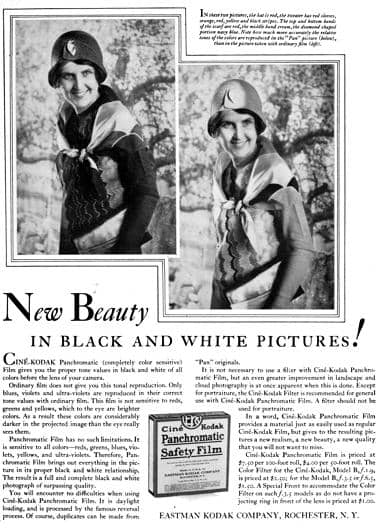
1929 Ciné-Kodak 16mm Panchromatic Safety Film.
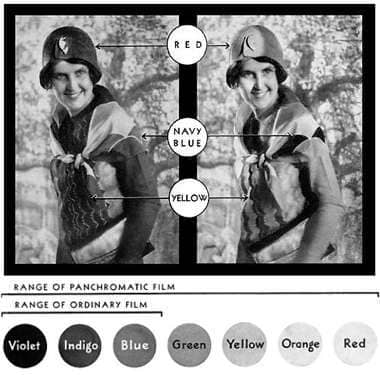
Panchromatic film (right) was much better than blue-sensitive/orthochromatic film (left) at rendering colour as shades of grey (Eastman Kodak).
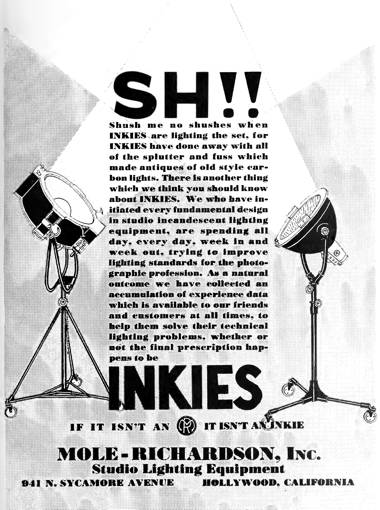
1929 ‘Inkies’. The firm of Mole-Richardson was formed in 1927 and quickly became the chief supplier of incandescent lighting to Hollywood. The fact that the lamps operated silently became an important consideration after the introduction of sound in 1927.
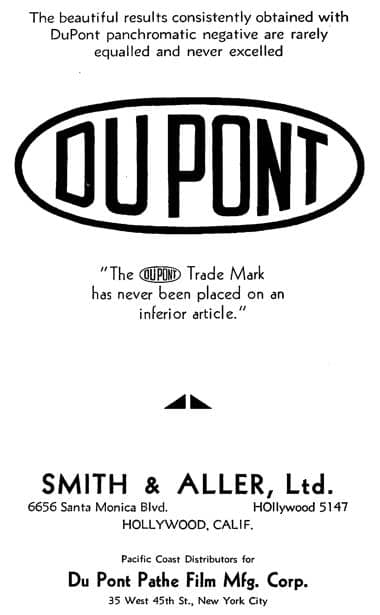
1931 Du Pont Panchromatic Film.
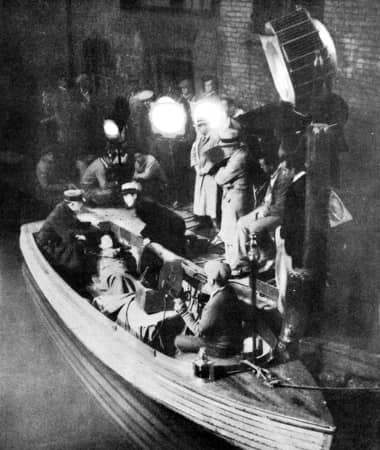
1931 Mazda ‘Inkies’ being used on a movie set.
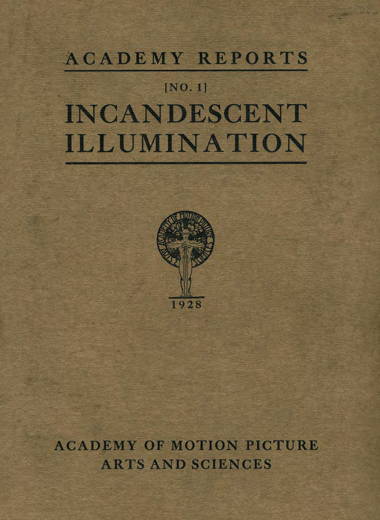
1928 The Academy of Motion Picture Arts and Sciences report on Incandescent illumination. The following is the make-up report delivered by David (Davis) Factor:
“At this occasion we wish to take time to express our sincere appreciation for the opportunity given us to work with you during the recent series of tests at the Warner Bros. studios. We thought it might be well to give briefly our opinions and findings regarding the effect of make-up when used under Incandescent lights with Panchromatic film.
At the beginning we watched the “rushes” of tests made under various conditions by a number of cinematographers and with make-up that was being used for other types of lighting, for both Panchromatic and Orthochromatic film. We noticed that almost every subject photographed was rather spotted and in some cases the lips were either very light or exceptionally dark. The lining of the eyebrows with the usual black pencil photographed harsh and was exceedingly conspicuous. We also noted that most lines under and above the eyelids would pick up rather sharp, thus forming a displeasing outline around the eye. Various shades of lining was used to shadow the upper eyelids, and it was very hard for us to determine just what colors were used.
When we first sent Mr. Kaufman on the set to take care of all make-up, we advised him to confine himself to certain shades of a neutral tone. We advised the use of brown eye-shadow and brown lip rouge. We also advised the total elimination of all pink make-up and black lines around the eyes.
When we first viewed the pictures in which the make-up in the preceding paragraph was used, we found that the tones of grease paint were correct, but that we would have to prepare certain shades in order to have a variance to suit the different complexions of both men and women. We also noted that the results from the brown lip rouge and dark eye-shadow were sometimes light and sometimes dark.
During the latter weeks of the tests we worked out a series of colors of Grease Paint, Powder, Eye Shadow, Lip Rouge and Pencils, which we thought would prove satisfactory. Subsequent testing proved conclusively that the tones and shades were correct.
We particularly invite your attention to the manner in which the features of the face blended. The photographic value of the pigments used in the preparation of these make-ups, were such that the resulting subject on the screen was soft and the texture of the skin itself photographed natural, eliminating all possibility of unnaturalness.
Those who remember the tests of Donald Keith will recall how lifelike he photographed. There was a very slight semblance of sheen on the face forming the same natural highlights that we see when talking face to face with any person. The various shades were tried on all types, both blondes and brunettes, male and female.
After the tests with Incandescent lighting and Panchromatic film, we made several tests under Arc lights and Orthochromatic film, and with Arc lights and Panchromatic film, and found that the make-ups photographed exceptionally well in all cases.
The new type of make-up was used during the final weeks of the tests and we carefully noted the results. Invariably the subjects appeared remarkably natural on the screen. The usual sharp and sometimes hard lines, that we so often encountered around the eyes and the lips, were now blended together into such harmony that no certain facial feature was more conspicuous than another. It seems to lend more to attracting the eye to the natural face in its entirety, instead of towards the eyes, mouth or any other strong feature.
As a result we feel that subjects used in motion pictures can greatly increase their photographic capabilities through the harmonizing and blending together of the facial features, and at the same time give to the cinematographer a smooth skin surface of such color value that he will experience little difficulty in the manipulation of his lights.
To go back to the make-up itself, we would like to explain a few of the new features that are worthy of attention.
The pigments used in the preparation of the make-up are balanced to the same degree in both the grease paint and the powder. As a result the color of the powder is the same as the grease paint. Ordinarily a powder lighter in shade than the grease paint was used, and the performer, after repowdering three or four times a day, had his make-up become lighter each time. At the end of the day the cinematographer was photographing performers in lighter make-ups than that which they had in the morning. But now, through the balancing of the pigments, the photographic value of the make-up does not change no matter how many times repowdering becomes necessary.
The shades of brown used on the eye and lips are prepared from the same pigments as the grease paint and the powder, only extended to darker tones. The shadows over the eyelids photograph soft and natural and the lips appear in a soft dark grey tone.
We also went very thoroughly into the question as to what type of base is best suited for the purpose of Motion Picture make-up. The problem confronting us was to determine whether the liquid base (which is also sometimes called as a paste make-up), or the grease paint were the better.
We have been studying this question for the past five years and our present efforts brought the decision favoring grease paint make-ups. It may be well for us to briefly give the reasons why we arrived at this conclusion.
The liquid or paste make-ups are composed of water soluble pigments. These pigments often times become darker after being applied to the face. This is due to perspiration. It being a fact that no person perspires evenly on every portion of the face, we find that in these particular places where the performer perspires more freely, that the make-up will often darken and register spotted and unevenly. Also, heat and light will draw color from a water soluble base much quicker than from an oil soluble. Therefore, there is the ever attendant danger of having make-ups change during the day and become either lighter or darker.
A number of well-known cinematographers can testify to the truth of this statement, and in our experience we know of certain specific instances where expensive re-takes were necessary for this reason.
On the other hand, when grease paint is made of pigments that have been properly extended to their highest degree, a uniformity is obtained that is reliable and may be depended upon to maintain the same color value for as long a period as might be required for photographic purposes. Only in rare cases have we found grease paint make-up becoming spotted. It also has been found that grease paint when properly applied photographs as a smooth, silky skin texture and absorbs sufficient light to keep it from going flat.
It might be well to state that we have manufactured both liquid and grease paint make-ups for the past twenty years. We do not wish to leave the impression that liquid make-up should not be used in motion picture work, as such a statement is not true. We find that the place where this type of make-up can be used to great advantage is for making up the entire bodies; for example, as used in the “Devil Dancer,” “Thief of Bagdad,” and various Arabian and Indian pictures for creating the native coloring of various races.
In such cases it is found as an ideal way of creating the desired coloring effects for such types. However, for use on the face, we maintain that grease paint is the safest and most reliable form of make-up, and we do not hesitate to recommend it.
We should also remember that with a grease paint make-up, the muscles of the face retain their natural elasticity and the artist does not feel the least bit conscious of having any make-up on his face; whereas, we often find that liquid make-ups dry and in drying they contract to the degree that they might draw up the tender muscles around the mouth and eyes and retard their flexibility.
In closing, we cannot stress the fact too much that make-up is the greatest ally of the cinematographer, and the most pliant tool of the artist. It is our opinion that the new type of make-up, which we have spoken of in this article and which we call Panchromatic make-up, will have a beneficial effect upon motion picture photography and should play an important part in prevention of re-takes.
In portrait photography the photographer touches up his plates after the sitting is made, but in motion picture photography the cinematographer resorts to make-up, to touch up the artist before he is photographed. We, therefore, feel that the question of make-up for Panchromatic film and Incandescent lighting as well as all other types of film and lighting systems, can be solved through the use of make-up of natural skin tones.
We also maintain that a grease paint base is the proper and most reliable form of make-up that can be used on the face. It is also our contention that the advent of Panchromatic film and Incandescent lighting does not mean the elimination of make-up, but that through the use of proper make-up, the quality of photography can be improved.
Allow us to add that we welcome all suggestions from anyone in the profession, and we would gladly go into any problems referring to the Art of Make-up as we feel that such criticisms and suggestions play an important part in the further development of this art.”
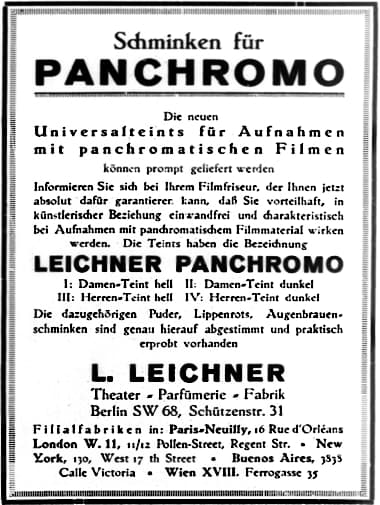
1928 Leichner Panchromo. L. Leichner introduced its make-up for panchromatic film in 1928. It came in four shades – Women (Light and Dark), and Men (Light and Dark) – as a cream (in tubes and jars), in sticks and as a powder.

1929 Trade advertisement for Panchromatic Make-up.

1929 Max Factor Panchromatic Make-up being packed into tubes.

1935 Eastman Super-Sensitive Panchromatic Negative.

Max Factor Panchromatic Make-up (greasepaint and powder).
